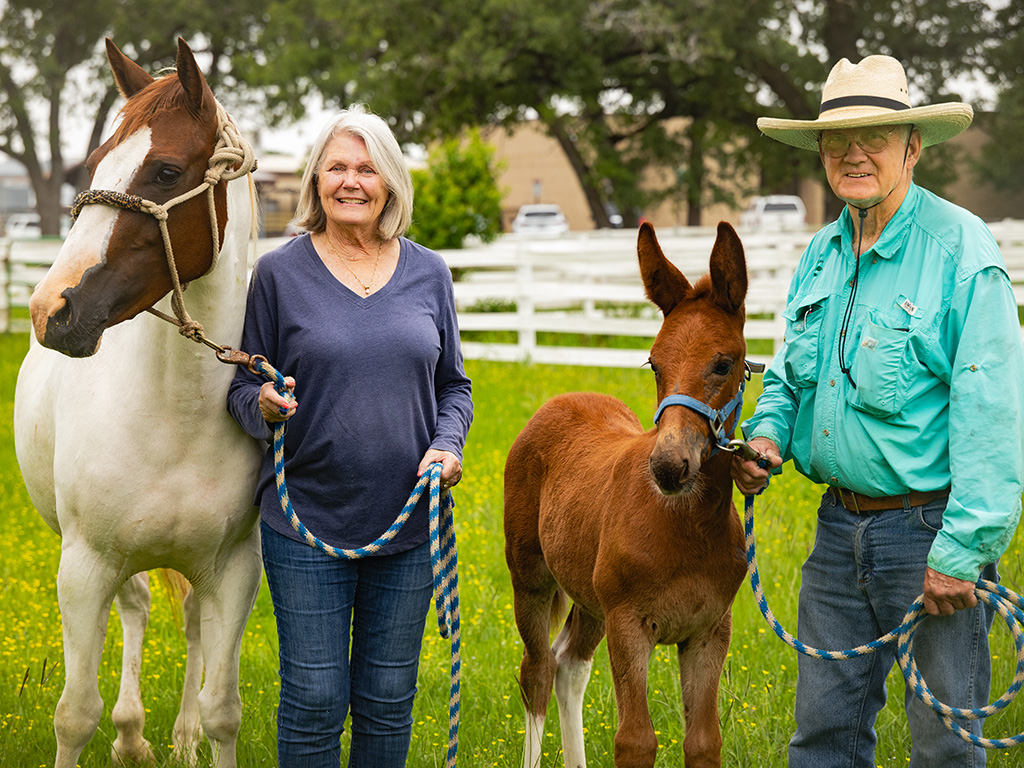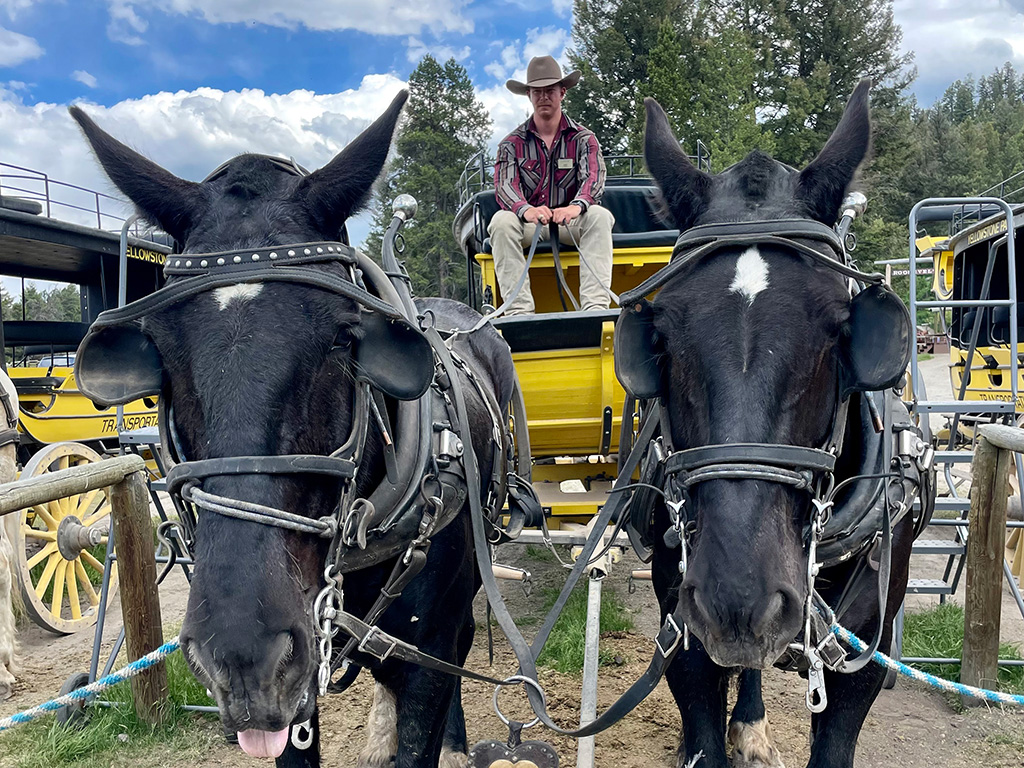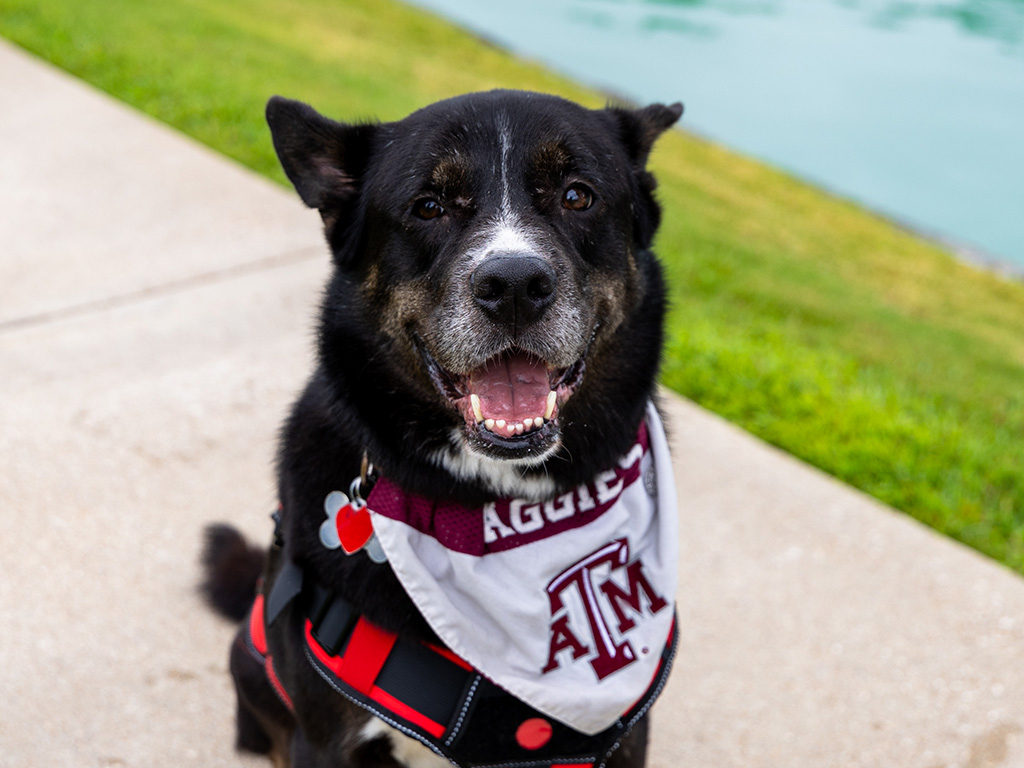Texas A&M, TDCJ Partner To Provide Learning Opportunities For Veterinary Students
Story by Megan Bennett, VMBS Marketing & Communications
A partnership unlike any other in the state is giving Texas A&M University veterinary students the unique opportunity to care for animals raised in Texas prison units.
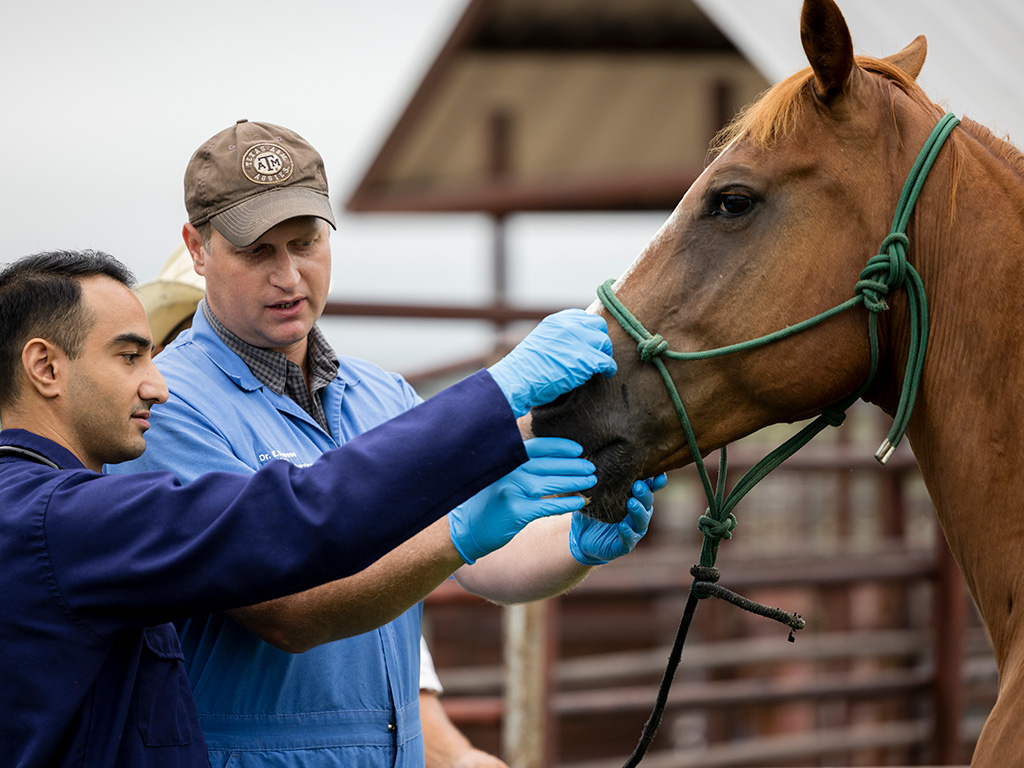
Across the state, correctional facilities provide inmates the opportunity to learn new skills. Thanks to a unique, inter-agency partnership, they’re also providing educational opportunities for veterinary students at the Texas A&M College of Veterinary Medicine & Biomedical Sciences (VMBS).
More than 200,000 cattle, chickens, pigs, horses, and dogs reside at 52 Texas Department of Criminal Justice (TDCJ) prison units across the state for food or security purposes. While these animals receive their daily care from prison inmates and staff, their medical care — which can include annual exams, dental cleanings, and even surgeries — comes from Texas A&M’s fourth-year veterinary students who participate on the TDCJ clinical rotation.
Repetition is key to mastering any skill, and the VMBS’ partnership with TDCJ ensures that veterinary students get the practice they need to graduate as confident, day-one-ready veterinarians.
In the 2022-2023 fiscal year, 145 students performed 9,536 cattle pregnancy diagnoses, 3,452 equine exams, and 1,155 canine exams at TDCJ prison units. Students completing the rotation during the cattle pregnancy season averaged nearly 500 palpations each, a unique opportunity thanks to the ongoing partnership between the two state agencies.
“The students get to do a lot of the same things over and over; that can sound monotonous, but as a student, being able to do things repeatedly until you feel comfortable is a big benefit,” said Dr. Eric Kneese ‘12, a clinical assistant professor and the Dr. Donald Bruce Lawhorn Endowed Faculty Fellow in Swine Medicine. “There probably isn’t anywhere else within a two- or three-hour radius of Bryan-College Station where they can go out and see the number and variety of species of animals we do.”
Offering Unique Opportunities
Kneese is one of four VMBS faculty members who lead the rotation and supervise the students’ work. He’s joined by Drs. Katherine Maples ‘13, a clinical assistant professor; Megan Pratt, a clinical assistant professor; and Joseph Blount ‘20, a clinical assistant professor who joined the VMBS in July.
“I took this rotation as a student and now that I’ve had the opportunity to come back and teach, I’ve gotten much more knowledge about the entire system and how can we help them,” Kneese said. “I love getting to see the breadth of this partnership.”
Rotation days begin at dawn, when faculty members and a group of four to eight veterinary students meet at the VMBS to travel to one of the TDCJ prisons. In the summer, they’re up before the sun to beat the heat; in the winter, they work quickly to pack as much into the shorter days as possible.
“We will work throughout the day, probably spending a good six to eight hours in the field on most days,” Kneese said. “Our days can be really stretched out based on how far we have to travel.”
While the season and prison unit’s needs determine what veterinary care is provided, a day could include anything from physical exams for prison working dogs, to teeth floats for horses, to breeding soundness exams for bulls. Upon arrival, students split into teams to focus on the skills they feel would be most beneficial for their future career paths.
“Sometimes we all go to the same place, but a lot of times, we divide and give students the opportunity to go to help with pigs or chickens or dogs,” Maples said. “We allow them to choose what would be most educational for them.
“They also get the opportunity to be the primary person performing most of the skills,” she said. “We try really hard to be very practical and private practice-like, instilling in the students what treatments would be reasonable and how you offer all the different options to a client.”
After a full day’s work, the team packs up and heads back home or to a local hotel, depending on how far they’ve traveled to reach the prison unit.
Every moment is an educational opportunity, though, even those spent on the road.
“I try to involve the students with everything,” Kneese said. “That includes emergency situations. You can’t have 52 locations — from Dalhart to El Paso and Texarkana to Edinburg — and not have something you’ve got to deal with via telehealth. A lot of times, we’re driving in the vehicle and having a discussion about what we need to do for an emergency several towns away.”
Taking A Proactive Approach
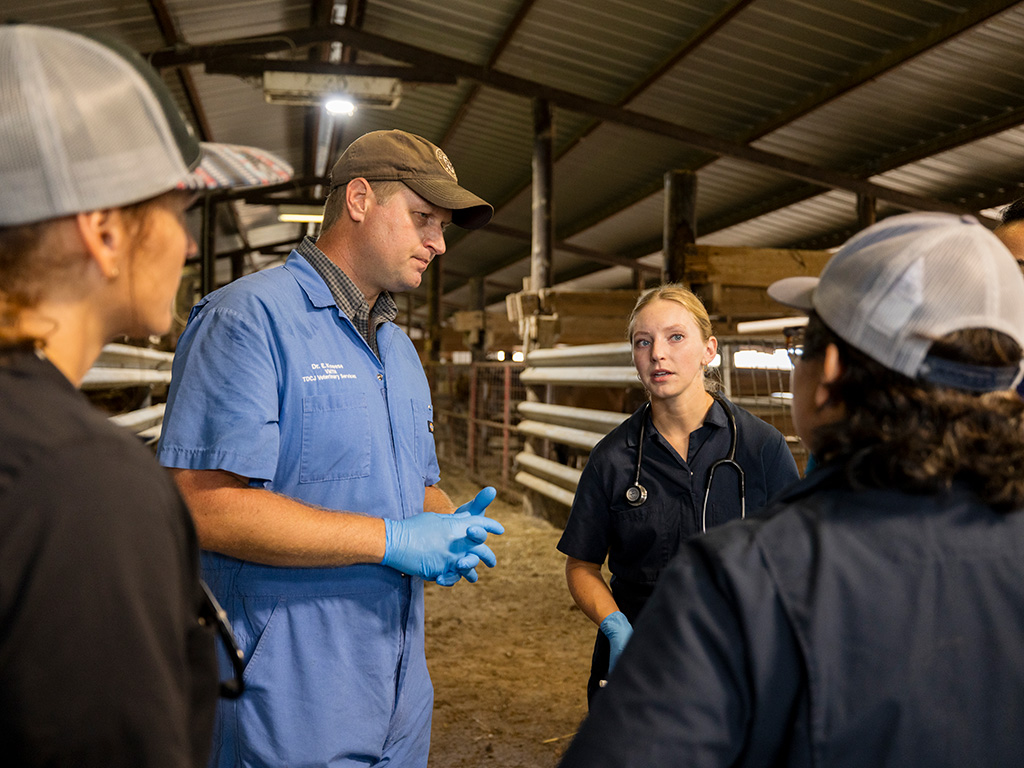
Providing veterinary care to thousands of animals is as much about prevention as it is responding to health problems.
“We’re trying to be more preventative in our approach,” Maples said. “That’s a great learning opportunity for the students, too, to see the ramifications and financial benefit of making a simple change.
“A good example is that we’re trying to strategically start doing more preventative dental care, rather than reacting to problems as they arise,” Maples said. “This will help the dogs and give students more opportunities to do dental cleanings.”
Maples recently received a high-impact instructional grant award from the VMBS to purchase new dentistry and anesthesia equipment for the approximately 2,000 horses and 1,000 dogs that reside at TDCJ facilities.
“The previous machines were donated back when I was a student, so they were pretty well-loved by now,” Maples said. “By purchasing new, really nice equipment, we can provide the level of care we want to provide to our patients, as well as teach students the current standard of care.”
This proactive approach also includes students drafting protocols for the prisons to follow in managing the health and needs of so many animals. The experience is great for students because it provides practice in working with a client to improve their animals’ overall health and well-being.
“This is a one-of-a-kind opportunity,” said Sara Zunker, a fourth-year veterinary student who recently completed the TDCJ rotation. “The clinicians create such a welcoming, supportive environment for students to learn in. You get the space to build confidence in your technical skills because there are so many animals to work with.”
Serving Texas
Beyond benefiting students’ education, the partnership is advantageous because of how it supports TDCJ, its animals, and the people of Texas.
“Nearly 100% of TDCJ’s veterinary care is provided by Texas A&M,” Kneese said. “If something emergent comes up at one of the more distant locations, we’ve got to send them to a local veterinarian, but we’re the only agency partnership that provides veterinary care for TDCJ.
“If we put a dollar amount on what we do, it’s well over a million dollars’ worth of work every year; our contract is for about half of that,” he said. “From a taxpayer standpoint, that’s huge — that’s money the taxpayers aren’t having to shell out. On top of that, both our students and the inmates are learning. Teaming up is really beneficial for both sides.”
“Maintaining the agribusiness operation would be a significant challenge without Texas A&M,” said Bill Lewis, TDCJ division director for manufacturing, agribusiness, and logistics. “This relationship is so instrumental in what we do, not only to provide our livestock adequate care but also when we utilize a lot of that livestock to feed our inmate populations and for revenue when we sell cattle. That’s not going to happen without this relationship between Texas A&M and the Texas Department of Criminal Justice.”
Because many of the TDCJ animals are livestock for food purposes, caring for the full herd in addition to each individual animal is important for maximizing productivity. Knowing how to examine overall herd health is a critical skill for students planning to enter the livestock industry or serve rural communities.
“We want to instill in our students how to look at data from a herd, flock, or pack and give recommendations from a consulting side, not just going out and taking care of an individual animal,” Kneese said. “On the cow side alone, TDCJ has expanded and improved their pregnancy rates and weaning weights. Same on the chicken side; they went from 150,000 eggs a day to over 180,000 eggs a day thanks to recommendations from our team.”
In the end, every decision made takes both the animals and students into account, with the ultimate goal being to provide TDCJ with the best service possible.
“We’re very student- and client-driven,” Kneese said. “We’re focused on what TDCJ needs but also trying to get the students what they need for their education.”
Looking Ahead

In addition to continuing to focus on preventative care, VMBS faculty are looking forward to growing the partnership in other ways.
“We have a practice model that could be beneficial for students to not only see from a medical standpoint but also from a business aspect,” Kneese said. “I would love to see them look at and analyze the business and management aspects using all the critical-thinking skills that they’ve been taught in the first three years of their veterinary curriculum.”
Students also have increasing opportunities to train prison inmates on how to safely handle animals during veterinary procedures, a skill that can directly impact job opportunities upon their release. This gives students the chance to develop leadership and training skills that will be essential for success in their future careers as well.
“It’s probably the most amazing thing I’ve ever done, getting to work alongside the inmates,” said Arvin Azizi, another fourth-year veterinary student who recently completed the TDCJ rotation. “We’re very approachable and eager to teach them new skills. Once they leave here, they can apply those skills and join the workforce, so we’re really making an impact on their lives.”
Learning those skills has proven to be useful in not only helping former inmates find jobs but also reducing the chance that they will return to prison.
“We track inmates when they leave for up to three years,” Lewis said. “Texas has a phenomenal recidivism rate. It’s going to be in the low 20s, percentagewise, for the sizable population we have. Within the manufacturing, agribusiness, logistics division, our numbers show that that’s cut in half, at 8 to 9% of inmates returning back into custody.”
No matter how the rotation changes in the future, its focus will always be on providing students with the hands-on practice that turns them into day-one-ready veterinarians upon graduation.
“As a student, I loved this rotation because of the hands-on work, the sheer number of animals, and the repetition,” Maples said. “When I graduated, I felt so prepared to do the things that I had done on the TDCJ rotation.”
###
Note: This story originally appeared in the Fall 2024 issue of VMBS Today.
For more information about the Texas A&M College of Veterinary Medicine & Biomedical Sciences, please visit our website at vetmed.tamu.edu or join us on Facebook, Instagram, and Twitter.
Contact Information: Jennifer Gauntt, Director of VMBS Communications, Texas A&M College of Veterinary Medicine & Biomedical Sciences, jgauntt@cvm.tamu.edu, 979-862-4216
You May Also Like

